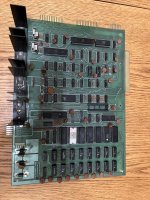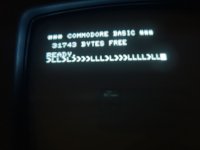Hello,
I recently got my hands on a Commodore PET 2001. Cosmetically it is in excellent condition but it doesn't seem to work very reliably. Loading from disk only occasionally works and a few hours after I first turned it on the keyboard stopped working reliably. Sometimes it prints the wrong characters, repeatedly prints wrong characters for as long as the key is pressed, or just doesn't work at all. The problem is NOT the keyboard mechanism itself as I have two working keyboards and the same thing happens on either.
The motherboard was pretty dirty and has some rust and corrosion. I decided to reseat all the removable chips, so I took them all out and gently cleaned every socket with isopropyl alcohol. When it dried however I noticed the entire board started streaking and now it looks even worse than it did before...
I have washed Macintosh stuff in a dishwasher or by hand before, but never something this old. I'm particularly worried about the ceramic capacitors, because some of them are pretty old and crusty looking.
Does anyone have any recommendations on how to proceed? I haven't powered it up since I applied the alcohol, in case the residue is conductive or something.
Attached is a before and after (pic without socketed chips is after).
I recently got my hands on a Commodore PET 2001. Cosmetically it is in excellent condition but it doesn't seem to work very reliably. Loading from disk only occasionally works and a few hours after I first turned it on the keyboard stopped working reliably. Sometimes it prints the wrong characters, repeatedly prints wrong characters for as long as the key is pressed, or just doesn't work at all. The problem is NOT the keyboard mechanism itself as I have two working keyboards and the same thing happens on either.
The motherboard was pretty dirty and has some rust and corrosion. I decided to reseat all the removable chips, so I took them all out and gently cleaned every socket with isopropyl alcohol. When it dried however I noticed the entire board started streaking and now it looks even worse than it did before...
I have washed Macintosh stuff in a dishwasher or by hand before, but never something this old. I'm particularly worried about the ceramic capacitors, because some of them are pretty old and crusty looking.
Does anyone have any recommendations on how to proceed? I haven't powered it up since I applied the alcohol, in case the residue is conductive or something.
Attached is a before and after (pic without socketed chips is after).



